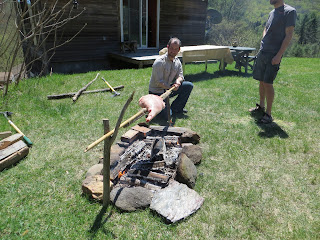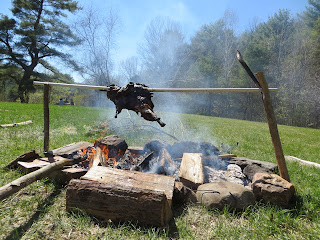Before we even get to the recipe, I just want to explain how happy I am right now. And to do that, I think you need to understand something about me. Here it is. I love chicken. No, seriously, I love chicken. I love the golden, crispy, salty skin and the tender, juicy meat. I love how chicken can go with almost any meal. But mostly it's that golden, crispy, salty skin. The only downside to chicken, until last night, was that while I've enjoyed many a delicious rotisserie in my day, I've never been able to produce a whole chicken that wasn't either:
- partially undercooked,
- partially overcooked,
- encrusted in an oily, undelicious mush more resembling a burnt latex glove coated in grease than the skin described earlier, or
- simply tasteless.
That has finally changed! And this in a poorly designed electric oven! So here it is, the maybe not-so-secret secret to delicious baked chicken:
STONES
That's it. Just take some tiles/stones/whatever (make sure they won't explode in the oven -- you can shell out some dough -- har har -- for a legit pizza stone, or get some household tiles from Home Depot; we used some leftover tiles from our hearth). Put them on the very top rack, and place the chicken on the rack below. About an hour later -- voila, feast.
We made this as a practice run for a Game of Thrones-themed feast we will be hosting in a couple of weeks. This one is definitely a go! OK, now I'm done with the fanfare. Here's the recipe, loosely adjusted from
A Feast of Ice and Fire.
Ingredients
1 whole chicken (innards removed)
2 Tbsp butter, melted
1 tsp kosher salt
1 cup apple cider vinegar
1 Tbsp butter
1-2 Tbsp honey
1-2 tsp basil
1/3 cup currants (raisins are an okay substitute if you don't have currants, but are sweeter, so adjust honey accordingly)
Procedure
Place tiles/stones on top rack of oven (so that they're generally covering the whole top rack), placing the top rack as high up as it will go. Preheat oven to 450F. Pat the chicken dry and place it in a glass baking dish. Rub all of the skin with the butter and then sprinkle salt evenly, rubbing it in with your fingers as well. Place on the rack below the tiles and bake for approximately an hour, or until the meat in the breast is cooked to at least 165 degrees. I think this took me about 70 minutes in all.
Meanwhile! Combine the other ingredients in a small pot and bring to a boil. Reduce heat to low and simmer, uncovered, for about 20-30 minutes, or until the mixture reduces to about half its original volume. When the chicken is done, add the pan drippings to the pot and simmer for another 5-10 minutes. Pour the resulting gravy over the chicken. Eat with your hands and say dumb medieval-sounding stuff for the rest of the night!
Serving suggestion
Serve with a chickpea salad (adapted from the same book): roasted chickpeas and currants/raisins on a bed of arugula, drizzled with and oil & vinegar dressing.
Reuse & Recycle!
Roasted chicken: the gift that keeps on giving. When you're done feasting, slice off any remaining meat from the carcass. This will be delicious in a sandwich or salad over the next few days. (Pictured: grilled sandwich with chicken breast, roasted chickpeas, muenster cheese, tomato, arugula, and spicy brown mustard.)
Save the carcass for making stock. You can dump the entire carcass into a big stockpot along with an onion or two and a few carrots, cover with water, and simmer, covered, on low heat for a good long while.











.jpg)
.jpg)
.jpg)


























.jpg)
.jpg)
.jpg)
.jpg)







